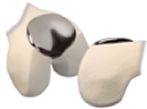Arthritis refers to inflammation, pain, swelling, or stiffness in a joint which is most frequently caused by wear and tear in the cartilage surface of bones. When this occurs, knee arthritis tends to progress. The knee is a naturally hard-working joint, but its function can be compromised by body weight, and other physiological stresses, which can accelerate such wear patterns.
Many times, knee deformities ensue causing the legs to become either bowed or knock-kneed. These deformities alter leg weight-bearing distribution and can also contribute to the progression of arthritis.



KNEE ANATOMY
The knee joint provides motion in the lower leg to perform activities such as walking, climbing, pivoting, and bending. This flexibility inflicts many forces and stresses across the knee joint. The ability to maintain these functions requires the knee to be comprised of numerous tissue types:
Bones
- Femur (thigh bone)
- Tibia (shin bone)
- Patella (kneecap)
Cartilage
- The covering on articulating surfaces of the bones
- Menisci
Ligaments
- Cruciates
- Collaterals
Muscles/tendons
These components of the knee work in conjunction to provide smooth, painless, and stable knee motion for everyday activities. However, injury to any of these parts of the knee can lead to pain.
CAUSES OF KNEE PAIN
Acute knee pain may begin after an identifiable cause or may be of recent or sudden onset. The most common acute knee injury types are:
- Fracture (bones)
- Musculotendinous strains (muscles/tendons)
- Sprains/dislocations (ligaments)
- Meniscal or osteochondral injuries (cartilage)
- Contusions (soft tissue or bone)
Acute knee pain is most commonly treated nonoperatively with rest, ice, elevation, and anti-inflammatory medications.
Pain which does not resolve is considered chronic pain. While there are multiple possible causes of chronic pain, osteoarthritis (the wear and tear of cartilage) is the most common cause.
Evaluation by a physician with radiographic studies is the most reliable method of diagnosing arthritis.
As cartilage is lost at the end of bones, the underlying bone is exposed. Motion in the joint now causes pain, swelling, stiffness, and sometimes catching or locking. Prior trauma or inflammatory arthritides can also damage cartilage, and the end result is similar. As the condition progresses, daily activities become more difficult to complete and lifestyles are limited.
Because the arthritic process cannot be reversed, eventually joint replacement options may be necessary.







